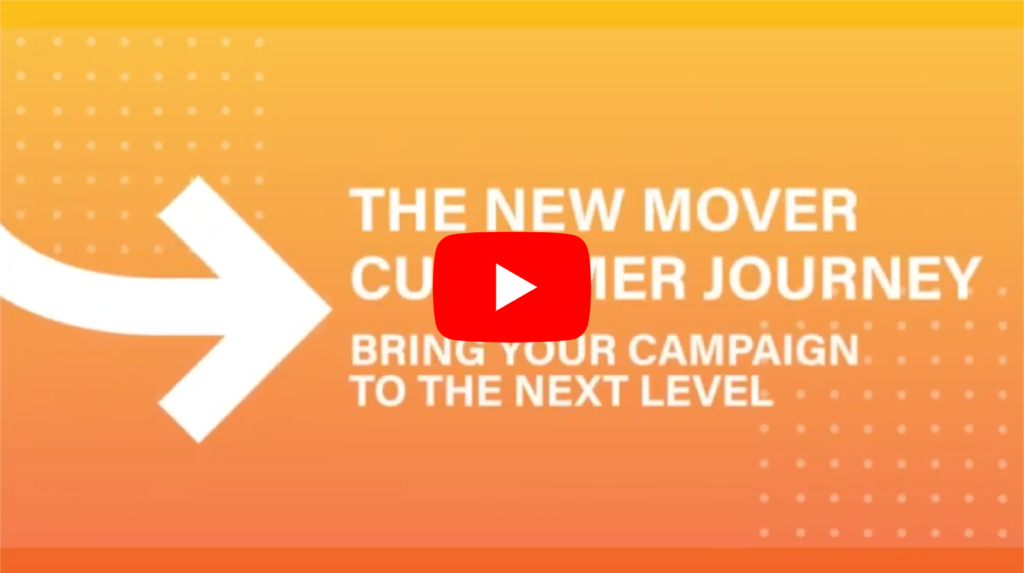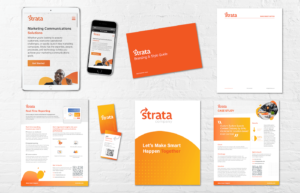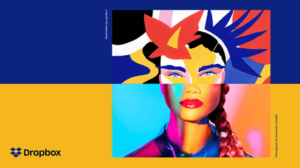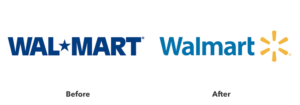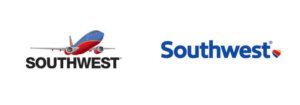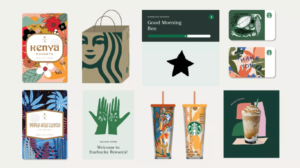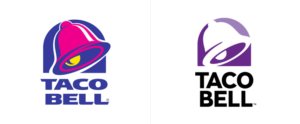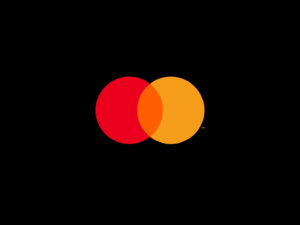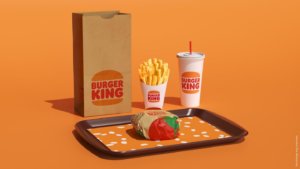What You Need to Know
In today’s world of marketing, we’re constantly surrounded by buzzwords – both old and new. As we evolve and keep up with the newest technology and trends, these buzzwords evolve as well. Yet, some buzzwords – like “Every Door Direct Mail”, otherwise known as EDDM, have stood the test of time for quite a while. In this blog, we’re breaking down this buzzword, walking you through its positives and negatives, and explaining when your company should or shouldn’t use it.
What is EDDM?
Every Door Direct Mail (better known as EDDM) from USPS is a blanketed mailing approach sent to potential customers near your business. USPS utilizes a mapping tool that holds demographic data based on census reports, such as age-range, household size, and income. Factors like these can help your company choose the routes you’d like to deliver your mail piece(s) to. Additionally, you can schedule that delivery for any time mail gets delivered.
You may create the mailer yourself, but it’s recommended you work with a company (like Strata) to help you design both professionally and effectively. The USPS website states, “Based on your unique business needs, either create an EDDM mailing yourself or get help with any part of the mail design, printing, preparation, and drop-off process using USPS affiliate vendors or find a local printer in the USPS Printer Directory.”
What Does it Cost?
The cost of EDDM varies, but it’s usually a lower cost option for marketing mail (which we’ll go over later on in this blog). You first have to choose between two options, EDDM Retail and EDDM BMEU, which you can read more in-depth about, here. The costs associated with these options are as follows:
- EDDM Retail® USPS Marketing Flats – $0.20 per piece
- EDDM BMEU USPS Marketing Mail Flats – as low as $0.168 per piece
What’s Good About EDDM?
EDDM is a good option to have if your marketing budget is low. It’s also possible to use it as a marketing test-run to see what audience members are most likely to respond to your communication (especially if you don’t have the budget for reporting).
It’s most often used for generalized, non-specific marketing awareness or brand campaigns. If you simply want to get the word out there – to anyone and everyone about your business, EDDM is an option to consider. Using EDDM can help you to avoid high postage rates, as long as you have a smaller print job in one geographic area.
Why Should I Consider Not Using EDDM?
EDDM definitely comes with its trade-offs. With it, you’ll lose the ability to target individuals based on very specified credentials, and won’t have as much leeway when it comes to time-to-market. Additionally, if your EDDM campaign is too large the cost savings you’d get with postage would be practically meaningless due to the increase in production processing. Lastly, EDDM doesn’t give you any options in terms of personalization – which, if you’ve read some of our blogs, you know is important in direct mail campaign effectiveness and ROI.
What are the Alternatives?
Before using EDDM, think through other ways you can get your message across, and who you’re trying to get that message to. Instead of using a blanketed geographic approach, you may want to try a more specified campaign like our SmartMove services (personalized, multi-touch mail that’s sent specifically to new movers). This way, you can better pin-point your audience, and provide a better experience to those who receive your mail.
Or, maybe the best marketing strategy for your company isn’t even mail at all, or is mail that includes a digital touchpoint. A more multichannel campaign could be your answer.
EDDM isn’t for every company and its marketing strategy – but as experts in the industry, we can say that it works for some companies. Yet, there are many times a more targeted strategy, like our new mover marketing options, will work better. Wondering how you can get started on your next direct mail or multichannel campaign? We’re here to help. Simply contact us whenever you’re ready.
A Look at Some of Our Favorite Customer-Focused Campaigns
Although we could write several blogs about all the great marketing campaigns that inspire and motivate us to be the best marketers possible and make the most effective material – in this blog, we’re looking at a few that we really admire because of how relatable and real they are. We’ll be breaking them down, thinking through what made them so successful, and in turn – helping you brainstorm your next campaign. Follow along as we dive into these customer-centric campaign leaders.
Apple’s #ShotoniPhone Campaign
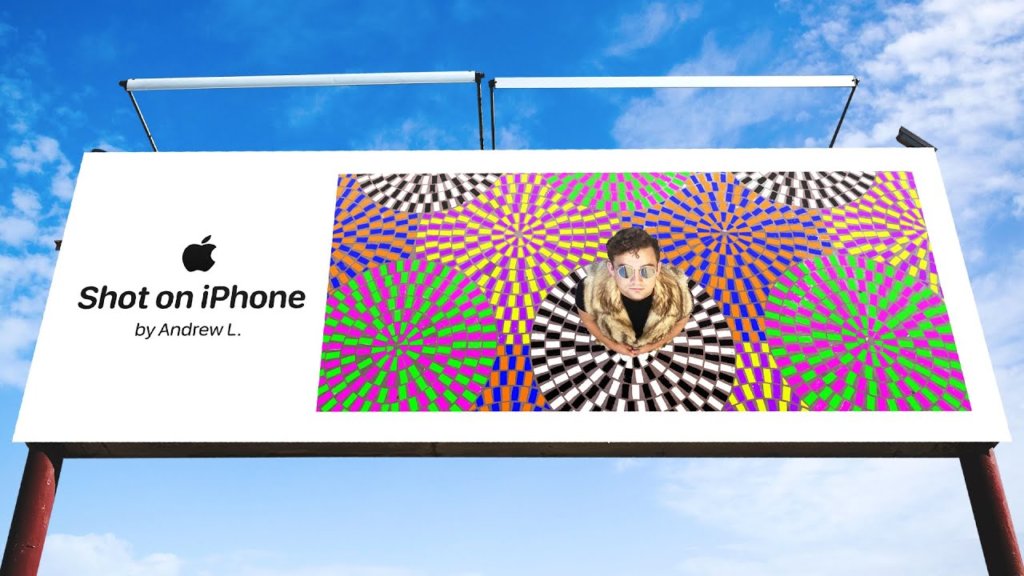
No matter where you’re located – you’ve likely seen this one around town. On billboards, buses, signs, or online. iPhone and Apple’s popularity is pretty known, but what we didn’t know when the iPhone first became popular was that it would eventually completely replace the digital camera. And that’s what this campaign shows; that you can take photos with your iPhone that are as beautiful as a camera that would cost you thousands. That’s great and all, but that alone would not convince people of today. So, why’s this campaign so successful? It gets real people involved. It’s relatable. The photos are not only from real Apple customers – but include their names. If someone wanted to, they could look up the name of the person in the bottom corner associated with taking the photo and learn more about who that person is. The best part? Not all of these people are photographers, showing that anyone could use the iPhone to take great photos. This tactic is pretty genius and builds trust – as no one would really care if it was simply a generic photo that easily could have been taken on a Canon. “According to various studies, over half (51%) of Americans trust user-generated content more than other information on a company website and claim that it influences what they buy and where they buy it from.”
Coors Light’s #CouldUseABeer Campaign
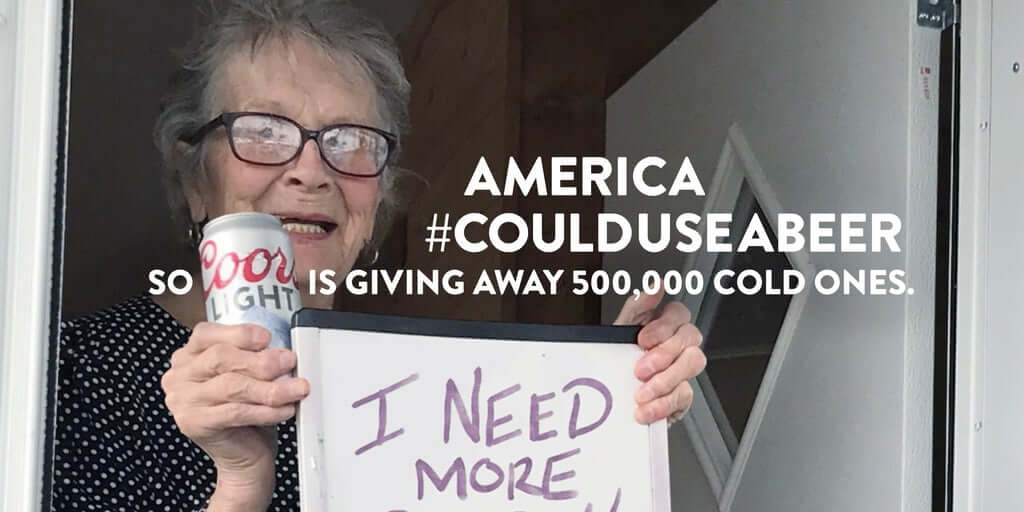
Another campaign that spoke to the general public and got them involved during a difficult time? Coors Light’s #CouldUseABeer. After a photo of a quarantined, 93-year-old woman asking for a beer went viral, Coors Light engaged with its audience by offering free six packs to anyone who was tweeted about (who – you guessed it, could use a beer). This tactic of giving away free items may seem pretty crazy, but it can go a long way. Although Coors Light gave away over 500,000 beers, their name was tweeted about again and again, which led them to trend, and boosted their reputation in a time of need.
American Apparel’s Direct Email Marketing
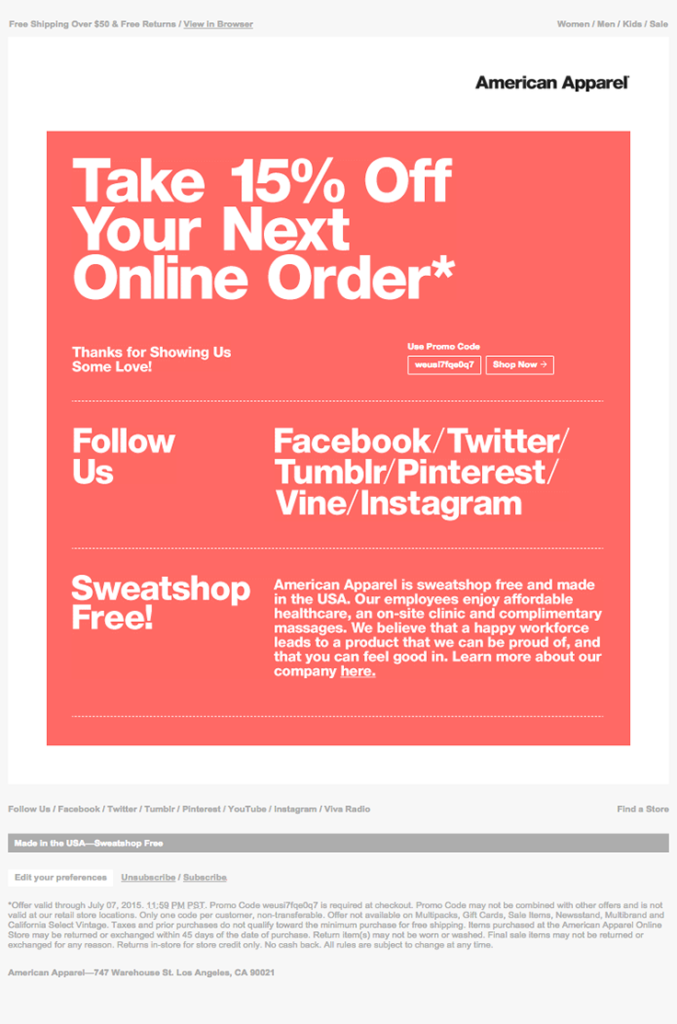
Known for being trendy and modern, American Apparel is no stranger to effective, up-to-date, customer-centric marketing. We’re specifically impressed with their to-the-point email marketing. No frills, no fluff – just what the customer wants (sales, discounts, and freebies). American Apparel always ensures that there’s no guesswork for their customers. Simple and sleek, their emails are call-to-action forward without being in-your-face.
Mercedes’ “Like You” Campaign

How do you relate a high-end brand to a broader audience of customers? Relate it to them, literally. Mercedes’ “Like You” campaign did just that. Called to several different types of audiences with phrases like, “Detail-obsessed, like you”, “Groundbreaking, like you”, “Original, like you” and “Curious, like you”. And not only was this phrasing compelling, but consistent. For the span of the campaign, potential customers could find the phrasing on billboards, signs, online ads, and on tv. The consistency was key, in that potential customers began to associate themselves with the brand and possibly even buy a Mercedes.
Airbnb’s Use of User Generated Content

Similar to Apple’s tactic, Airbnb uses the photos, videos, and feedback of its customers in its campaigns to promote beautifully classic or uniquely interesting places to stay. “Millennials spend 30% of their media time (5 hours/day) engaged with user-generated content (UGC). Coincidently, this is the same generation that drives Airbnb’s success in the sharing economy.” Airbnb keeps things personal and personalized by including its audience, which facilitates a happy and loyal community of customers.
Coca Cola’s Share a Coke Multichannel Campaign
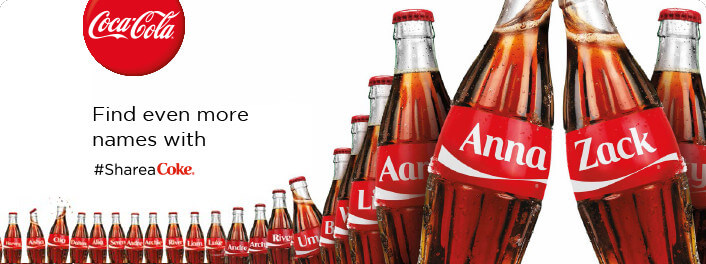
We all know this one. There’s nothing more personal than having your own name on a Coke bottle – which is exactly what Coca Cola did for its ongoing “Share a Coke” campaign. Whether you customize your bottle or simply find your name in store, you’re likely to share it with the world through text, email, on social, you name it (no pun intended)! And its rollout in 2011 sure worked in building brand awareness, boosting sales, and creating positive brand recognition, as “Young adult consumption increased significantly during the campaign, up by 7%, making 2011 the most successful summer ever. The campaign earned a total of 18,300,000-plus media impressions.”
Spotify’s #2020Wrapped Campaign
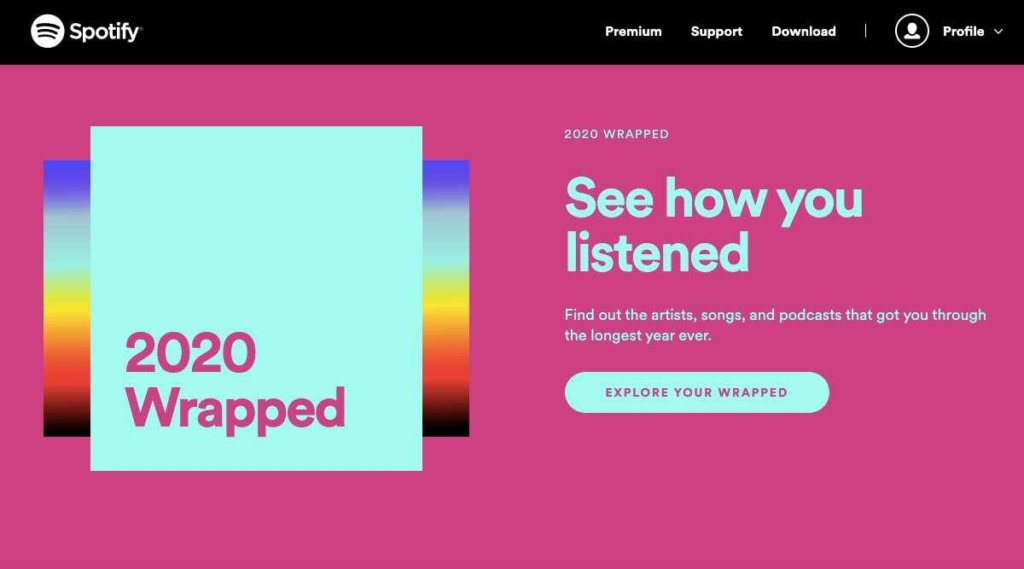
If you have any form of social media, you’ll likely remember this campaign flooding your feed, and maybe you even took part in it. At the end of 2020, Spotify allowed its customers to see their year of music with “2020 Wrapped”, which compiled their listening into a lovely array of photos and stats. Viewers loved seeing their personal data compiled into a nicely packaged marketing piece – and loved sharing their interests with others. Smart on Spotify’s end, because it not only gave them free marketing, but boosted their recognition.
So, What Have We Learned?
If you haven’t noticed, most of these campaigns share one key factor; relatability. How can you use relatability to create effective campaigns, too? Know your audience. Before even starting to brainstorm a campaign, make sure you’re fully aware of who, where, and when you’re targeting. And when you do start your campaign based off your findings, use that data and understanding to carefully craft consistent messaging that includes clear call-to-actions and personalized, catered content. Use hashtags, giveaways, QR codes, PURLs, BRCs, and more to engage with your audience and include them in your campaign. And, when and if appropriate, sprinkle in some humor.
Interested in making an impactful, relatable campaign that can help boost your company’s marketing efforts? Not sure exactly where to start? Look no further. Strata’s here to help. Contact us today to get the brainstorming started.
All Your Questions Answered
There’s a lot of buzz around new mover marketing and the best ways to target potential new customers. And with all the attention and noise around it, the topic can get confusing and leave a lot of essential questions unanswered. Today, we’re going to answer all your questions about new mover marketing – and give you some insight into how to start a successful and smart new mover campaign.
Why should I target new movers in the first place?
Easy answer. With over 13% of Americans moving ever year, a ton of new movers are not only new to your area, but are looking for your business. They’re in a stage where they’re starting to develop what will become habitual shopping/buying habits and not looking for a reason to spend, but where to spend. Recent surveys show that 80% of new movers are willing to try new products since they’re in a new market and searching for new businesses and services. Also, how else are you going to replace those long-term, current clients that are moving out of your market area?
In what industries is new mover marketing effective?
Movers moving into a new house spend on average, $9,400 post-move, and that’s split into several different industries depending on the individual. When people move to new areas, they have several new (and already existing) needs that can only be met by several different industries. This means a new grocer, new healthcare provider, new dentist, new restaurants, a new gym… list goes on and on (and on).
Is it possible to segment who I target?
Yes, you can segment who you’re targeting based off age, demographic, and even by household income, to identify your ideal customer profile. The level of available segmentation depends on your new mover marketing partner and the technology that’s provided, but it can (and has been) done.
Can I have more than one touch point across several channels?
Absolutely! We recommend implementing multiple touch points that come from different angles. This means reaching your customers through several different channels, such as digital, direct mail, and email. All of these channels of communication, used together and correctly, are proven to show effective ROI.
How can I grow my new mover market through direct mail?
With around 61% of customers finding direct mail influential in making purchasing decisions, it’s important to make it one of the cornerstones of your new mover marketing campaigns. Direct mail can be personalized for the consumer, be authentic to your brand, and provides opportunity to be creative with how you market products and services to your consumers. Mailers that typically work best for new movers are dimensional mail, postcards, and bi-folds with incentive items.
How can I grow my new mover customer base with digital ads?
Hand in hand with direct mail, digital ads are excellent in getting your company’s name across your potential customer’s device. Creating display and banner advertisements is an effective way to send customers to your website or to a specific landing page. The power of digital marketing often speaks for itself, so it’s important to have elements of it involved in your new mover marketing campaign to reach all potential customers – not just some.
What kinds of responses should I expect throughout my campaign?
This all depends on the structure of your campaign and what kind of responses you’re aiming for. For instance, if you include a business reply card (BRC) within your direct mailer, your response rate will be based off how many potential customers fill them out and return them. Furthermore, the more aggressive your offer is for a direct response, the greater the response will be. Responses typically vary between industry and how many different touch points are built into your campaign. Response rates can also be determined by digital ads based off the number of consumers that interact with your landing page by clicks or submitted forms.
What’s the best way to track responses from my campaign?
When executing a new mover marketing campaign, make sure the program you’re using can easily track all progress, responses, and data that comes with the campaign. Find a partner with access to technology that allows you to see real time responses for your campaign and gain intelligence from those responses to make adjustments as it’s executed.
How do I effectively set up a new mover marketing campaign?
Picking the right partner is everything when it comes to successfully setting up a new mover marketing campaign. The right partner will provide the right data, the right technology, and a partnership with strong content creators who will represent your brand correctly. Work with a company that understands your markets and has several years of experience.
Looking for ways to incorporate a new mover marketing strategy into your next campaign? Here at Strata, we have years and years (and years) of experience under our belts. We’re here to assist you with all your new mover marketing questions and needs. Contact us today.
Bring Your Campaign to the Next Level
With over 40 million people moving every year, there’s a huge market for new customers moving into your target area. That said, many businesses have no idea where to start when it comes to targeting and reaching these new movers. Today, we’ll give you an overview of what new mover marketing is, the customer journey that a new mover takes, and the best channels and campaigns to reach them. Let’s dive in!
From Movers to Buyers
One of the most important things to realize about new movers is that they’re currently nobody’s loyal customer (yet). They’re a key group to target because they’re open to new businesses and products, and on average, develop 72 or more new business relationships within one year of moving. They’re also 5 times more loyal than your regular customer due to being new to the area. Once they find something they like, they’re willing to frequently buy it with ease. Making up 17% of the U.S. population, you can’t afford to miss these walking (and unpacking) opportunities. So, how are their (frequently loyal) buying habits formed? New movers are heavily influenced by timing. Whether you contact them before or after their move decides how they feel about your communication, and what they’ll do about it…
Pre-Move Buying Habits
Data shows that movers begin to stock up on home items right before they move. Products such as kitchen utensils, light fixtures, and everyday household tools are high on their list during this pre-move time.
Post-Move Buying Habits
After their move, new home buyers are likely to spend an average of $9,400, while renters spend around $4,700. Still, this number varies with age, area and demographic. Most of these buying decisions are made within the first few months of moving, which makes it the best time for your company to make contact, introduce yourself, and showcase your product.
A new mover’s first purchases will depend on their personal needs and priorities. For instance, a mover with medical needs may find a doctor immediately, while a mover with a large family may first find a new grocery store. Either way, they’ll have to find both eventually – and it’s likely they will within the first few months. Thankfully, new movers don’t need to be convinced to buy (they’re already more than ready), you’ll just need to convince them to make the right buy (from your company).
Staying in Touch
It’s not only important to get in touch with these potential loyal customers, but to stay in touch. After making a strong first impression, you’ll want to make more points of contact to ensure your company stays top of mind. It’s essential you have a good combination of marketing across several channels that are strategically picked and placed.
New Mover Marketing Tactics
There are several ways to reach these new movers, first, but since we’re experts – we’ll tell you the best ones. First is direct mail. Direct mail ideally arrives at the same time or a few days after new movers enter your neighborhood. Delivering direct mail that welcomes and attracts the new mover while introducing your business is a great way to begin an ongoing relationship. And the stats back this up – as 40% of consumers try new businesses after receiving direct mail. Direct mail is perfect as a first touch to new movers, as it’s personalized, meets them in their new home, and catches them at the right time.
A great way to ensure this direct mail delivers ROI is through BRCs (business reply cards) or eBRCs with incentives. A BRC is a vehicle that allows a prospective customer to provide information to send back to your business, and if incentivized, can return high response rates and bring you valuable customer data.
What’s the next best channel for reaching new movers? Digital advertising. Hand in hand with direct mail, digital ads can create brand awareness, link to your chosen landing page, and target specific online audiences. Digital advertisement placement and audience targeting are the top optimization tactics used by advertisers today.
Email is next – and combined with both direct mail and digital ads, email can be that final touch that brings your company new customers. Using either the BRC information or engagement with digital ads, emails are easy to obtain, making it almost effortless to add new customers to your automated or personalized promotional email campaigns.
The Visible Influence
New mover marketing allows marketers to influence movers’ buying decisions from the beginning of their move all the way until they walk into your doors. It’s about building immediate and vital relationships – because once a new mover buys from you and your shop, they’re 90% more likely to become a repeat customer.
If you want to dig even deeper, it’s smart to use a program that gives your business insight into your customers – such as live statistics and touchpoint behaviors. These meaningful insights will allow your shop to make enhancements on the fly and improve your campaigns, ultimately increasing ROI.
If you successfully target new movers, create convenient touchpoints that meet their needs, and maintain conversation as they have questions and reach out, the new mover will not only finish their journey as a customer, but as a loyal, repeat one. Looking for ways to incorporate a new mover marketing strategy into your next campaign? With years and years (and years) of experience under our belts, we’re new mover marketing experts. Contact us today.
How to Attract Your Audience
Video ads aren’t anything new, but keeping up with the rise of their increasing online presence is. Most of us don’t even realize how often we come across video ads. With so many different apps and sites, it’s important to get your company’s video ads out there, in the right places, and noticed. The key is to look beyond traditional practices and dig deeper into the variety of different ways and places you can utilize them. Follow along as we take you through best practices for video ads.
Rise of Video
With the rise of social media and its many marketing uses; video advertisements have been more popular than ever before. So popular that, in the past 30 days, more video content has been uploaded than video created by major U.S. television networks in the past 30 years. Moreover, it’s estimated that the average person currently spends 100 minutes every day watching online videos. This is a 19% increase compared to daily viewing minutes in 2019, which stood at 84. What all of this means is that it’s not just that people are watching more video than ever before, but that competition for this space is on the rise. Stay on top of new trends and ways to engage your audience over your competitors with our five tips and tricks, below.
1. Choose the Right Video & Placement
The right video placement can be the determining factor for your video advertising success. Before anything else, make sure your company has a clear idea of where you want these ads to be – and where they’ll best meet your potential customers. Here are four highly successful video ad placements to keep in mind as you’re getting started.
Skippable in-Stream Ads: Skippable, in-stream ads play before, during, or after other videos. After five seconds, the viewer has the option to skip the ad.
Non-Skippable in-Stream Ads: Non-skippable in-stream ads are 15 seconds (or shorter) and play before, during, or after other videos. Viewers don’t have the option to skip the ad.
Native Video Ads: This video ad format blends in with the website’s layout for a seamless interaction.
In-Banner Video Ads: In-banner video ads are videos built inside a banner ads.
Knowing these four placements can allow for your brand and message to be properly delivered the way you’d like it to be within your diverse video ads.
2. Captivate
When we say captivate, we mean make a good first impression. It’s best to keep your videos around 15-60 seconds, because most of your audience may drop off if your ad drags on too long. The message may begin to get drawn out and blurry, causing the viewer to forget it. Short and sweet is the rule of thumb, and grabbing their attention in those first 3-5 seconds is key. You really don’t have much time before the viewer may click “skip ad” or exit out completely. Keep users engaged by using upbeat music, compelling questions, humor and more, based on your brand voice. Once you have your general ad idea ready, figure out the best place to position the ad. 79% of the people say a video ad has convinced them to buy a product or software – so make sure its length and creative makes it memorable. Not sure where to start? Take a look at one of our personal video ads below for inspiration.
3. Personalize
Online video ads tend to differ heavily from traditional television ads. This is primarily due to the personalization of online ads. Using personalization tactics can give you an impactful advantage over your competitors, so take advantage of this and research and study your customer demographics to better understand their behavior and buying patterns to properly place your ads in the right places. For example, if one of your demographic audiences viewed your services and clicked through the contact us page, but didn’t submit any information, you can infer that they got the chance and had the time to go through your website (showing some interest) and look over your services, but weren’t ready to take any next steps. In this case, a video ad with personalization could be used to help them progress, reading something like, “Learn more and get in contact with xyz to see how x company can help you with…” This way, you’re serving as an outlet and solution to their unanswered questions, and gently pushing them make that next step, instead of placing an ad for them to see that doesn’t apply to their current situation. The same goes for the placement of the video ad. If you find that the majority of your audience is viewing your content on Facebook or Instagram, place an ad within these platforms. Similarly, if you’re communicating a lot through email with potential customers, place a video ad in an email. An initial email with a video ad can receive an increased click-through rate of 96%. And, using the word “video” in your email’s subject line can increase open rates by 19%, click through rates by 65%, and cut the number of unsubscribes by 26%.
4. Make it Relevant
Make sure your ads are relevant. Don’t just interrupt your viewer in the middle of their browsing or shopping – add value to their day. Make them do a double take when scrolling to keep your company top of mind for your high performing audiences. The best way to do this is by empathizing with their needs and pain points, especially right off the bat (like we said, in that first 3-5 second). It’s helpful to create different or slightly different versions of the same video ad to ensure they fit seamlessly into whatever page they are placed on.
5. Represent Your Brand
Be sure, possibly above anything else, that each video is a good representation of your brand. Add a logo into the corner of the ad, or place it strategically within the video on certain frames. 3X more people are engaged with an ad when a brand name and message is presented in the first 10 seconds. Also be sure to include a clear & concise call to action (CTA), and use ad copy space to provide additional information about your product or service that didn’t make it into the video. You can even try adding a short teaser phrase or question to the video that compels people to view longer or check out your website, blog, landing page, or other platforms.
Reach Your Target Audience
Lastly, partner with advertising creatives to get your video ads done efficiently and in a timely manner. Having captivating, personalized, relevant information that’s positioned correctly will ultimately put your company in the best position possible to reach your target audience. If you’re looking to learn more about video ads, feel free to contact our skilled creative marketing team, here.
With the Top 10 (Other) Best Rebrands & Refreshes
We can’t believe we’re already celebrating the one-year anniversary of Strata’s brand refresh. It’s been quite a year (to say the least). But we can honestly say that, with all of the struggles of 2020-2021, our brand refresh wasn’t one of them. If it did anything (and it did a lot), it definitely brought us together, made us more confident, and better showcased our personality, vision, team, and solutions. The brand refresh catapulted Strata into 2020, helping us solidify our style and services, attract new talent, and stay inspired.
When we decided we needed a new look – we had to pick between a full rebrand or a refresh. For us, the answer was easy. A complete rebrand would have required scrapping our identity and starting from scratch, where a refresh allowed us to keep our main identity and strategy intact. Our brand was strong with our current clients and we had a great reputation as problem solvers and solutions experts – so a refresh was perfect for what we needed to do.
With any rebrand or brand refresh – “consistency across all channels is key”. Over the past year, we’ve ensured that all our materials – from website to print, are on-brand.
Since we now have a bit of rebrand and refresh experience under our belts, we wanted to take a look at the top 10 best company rebrands and refreshes (in our eyes) besides Strata’s, of course.
Our Top 10
Dropbox
Dropbox refreshed its brand in 2017, and it was nothing short of successful. The company worked with design studio “Collins” to create a cleaner and simpler logo and lots of illustrative elements to better connect with their primarily creative and collaborative audience.
Airbnb
Airbnb did a full rebrand in 2014 with Design Studio, sending their team of designers to 13 cities to truly immerse themselves in Airbnb’s offerings, community, and mission. It resulted in a beautiful brand that differentiated Airbnb from its similar competitors. The CEO of Airbnb even stated, “When I look at this brand, I suddenly realized everything I’ve been trying to say, now we have a way to express it.”
Walmart
“There are very few companies in the world that managed to change the public perception of their brand as successfully as Walmart did.” In 2008, Walmart made this change to get away from their “always low prices” slogan that often-made customers feel like it was also “always low quality”. They also wanted to steer clear of the questionable corporate practices they were called out for in the early 2000s. So, Walmart did a complete 360 with a whole new brand from redesigned stores to a new look and personality.
Southwest
We love this brand refresh because it reminds us of ours. Without a complete overhaul, Southwest changed its look and logo to showcase their humanity and heart – literally.
Guinness
Good old Guinness. Many love it, others don’t, but it always holds true that Guinness makes us feel like we’re back in the olden days, sipping a brew in the pub. Instead of following the crowd of flat logo designs, Guinness actually added detail to its logo in 2016, working “with real harp makers to breathe new life into the legendary logo” that “could be built into an actual harp that would work properly and be in tune.”
Starbucks
Starbucks is loved by many – and dare we say it – is mainly successful because of its brand (although we do love it a latte). They’ve made slight changes over time to the brand, always increasing their user experience and recognizability with a “distinctive color scheme, typography, and illustrations.”
Taco Bell
You may not have really noticed Taco Bell’s brand refresh until now – but its cleaner, simpler look has helped it stay relevant among its many fast food and taco chain competitors. Along with this well-done refresh, Taco Bell has been named “one of the healthiest fast-food chains in America,” so, they’re doing quite well.
Mastercard
In 2016, Mastercard conducted a refresh with Pentagram to emphasize “simplicity, connectivity and seamlessness.” It’s simple and sleek look of just the famous two overlapping circles is surprising, but logic-based. “The change follows research by Mastercard that found that more than three quarters of people asked were able to identify the brand from the two interlocking circles alone.
Burger King
For the first time in 20 years, Burger King conducted a brand refresh with a new logo, uniforms, and packaging – and we love its nostalgic look. The new logo is actually very close to BK’s logo design from the 70s-90s. The creative agency on the project wanted to “pay homage to the brand’s heritage with a refined design that’s confident, simple and fun.”
Intel
Last but not least, Intel’s 2020 refresh caught our eye because of its subtle hints to past logos. Again, it refers back to their past while being currently relevant. “This new logo includes elements of both (past logos), but in a much more subtle, minimalist way.”
To take a more in-depth look back at our brand refresh, visit our original refresh blog, here. If you’re looking to make your branding and marketing communications more effective and efficient, give Strata a call.
Get to Know These Tracking Treats
Within the world of marketing, there’s a lot of buzz around the topic of cookies and what the future holds for tracking website visitors and generating personalized advertisements. While the topic’s relevant, not many people are completely informed on what cookies are and the impact they have on our ability to create better customer experiences. In this blog, we’re going over what cookies are, the differences between first-party and third-party cookies, and the future of online tracking.
So, What Are “Cookies”?
Although many of us are “foodies” here at Strata, and could talk about a good dessert all day, this blog isn’t about Oreo or Chips Ahoy. We’re talking about web “cookies” – text files put into a user’s browser page while they’re visiting a website. Cookies are known by several names – web cookie, internet cookie, browser cookie, or HTTP cookie, but they’re all the same, and in general, they track and log browsing activity against identification data such as IP addresses. Why is this information useful? Primarily, cookies help save information about a user in order to personalize their website experience and the advertisements they’re shown.
While cookies have enjoyed a childhood free of regulation, their “free-willy” time is coming to an end with recent regulatory initiatives driven by an increase in public concern over internet privacy. The first major change came when General Data Protection Regulation (GDPR) made consent mandatory in order to track visitors on a website. To give you a feel for the impact of GDPR – about 11% of users click to “accept all cookies”, 76% of users ignore the banner completely, 12% close the cookie banner, and 0.5% of users actually open up cookie settings, read through terms and agreements, and sometimes make adjustments. These numbers are misleading, however – what GDPR essentially did was force the user to choose between viewing the desired content and accepting cookies OR (with exceptions) leaving the site entirely. So, while it looked good – almost all of the visitors in the stats above were still being tracked.
At this point, you might be thinking that we need to eradicate the cookie – if so, hold that thought. Cookies almost always make your experience on the web better – they’re your friend, not your enemy. To solve privacy concerns – which is the intent of all privacy-centric regulation – we’ll need to jump down a level. There are two major types of cookies – First-Party and Third-Party. Both contain the same pieces of data and technically can conduct the same actions, but they’re created differently, used differently, and have different benefits for distinctive situations. Let’s get into each one.
First-Party Cookies
Simply put, first party cookie technology is usually installed or authorized by a website’s owner and only tracks that user across that specific website. First-party cookies are set on the publisher’s server or on the JavaScript loaded to the website. Their defining technical feature is that, for the most part, only the domain that created the cookie can access it, thus they are seen as less invasive and are more welcomed by users.
These cookies allow website owners to collect analytical data, remember individual user settings or content (remembering what’s in a user’s shopping cart, their language preferences, or their username and password), and perform useful functions to provide better user experience. That last part is important – first-party cookies primary purpose is to deliver more relevant, user-friendly experiences to individuals. If you’d like to see the difference they make, just clear your browser cache and visit some of your favorite websites.
Third-Party Cookies
Contrasting first-party cookies, third-party cookies are not created by the domain of the website the user’s currently visiting, and therefore, can often seem intrusive and un-welcomed. This type of cookie is placed by another site, such as an advertiser or social media platform like ad.doubleclick.net – and is separate from the home domain. These cookies are usually used for online advertising purposes, and are added through a script, code, or tag to track a user across several websites. Enabling these cookies can help users see relevant discounts and catered advertisements, but can also possibly involve them in a breach of privacy. For this reason, third-party cookies are blocked by many browsers, and are currently being chastised as unethical.
Phase Out of Third-Party Cookies
In February of 2020, Google announced its phase out of third-party cookies by 2022. When this occurs, it will cause 56% of web browsers (the percentage that use Google Chrome) to block their use automatically. As stated by Google, their reasoning for forcing this phase out is to increase security and protect the user. You have to wonder, however – are ethics the driving principle here, or is this a strategic move to further corner the digital advertising market?
All-in-all, this change won’t make as much of a difference as you’d think, as a 2017 study showed that 64% of tracking cookies were already being blocked as users surfed the web. Those at Google seem to think that third-party cookies will not be replaced by another resource due to increasing privacy concerns, but they’ll continue to “support first-party relationships on our ad platforms for partners, in which they have direct connections with their own customers.”
What’s Next for Cookies?
No matter what the circumstances with third-party cookies, first-party cookies are definitely here to stay. If configured correctly, they’ll continue to function within most browsers – even if those browsers block third-party cookies. So – fear not – first-party cookies will provide marketers hindsight and insight on your website visitors for the foreseeable future – even if you might now be forced to use Google to reach them.
Now that you know a bit more about cookies, you may be motivated to improve and optimize your next digital marketing campaign. If so, contact us today.
7 Ideas for Your Digital Strategy
So far in the Power of Digital series, we’ve highlighted digital’s general power and presence in today’s world, and shared key tips and tricks to plan, execute, and get the most out of your digital marketing campaigns. This week, we’re shifting gears a bit to take you through 7 unique and effective ways you can use digital in your next marketing campaign.
1. Content Marketing
Content is key and king, and that will most likely never change. Especially on digital platforms, content can make or break your marketing campaign. Almost every channel can benefit from content marketing, but those that benefit most are websites, blogs, e-books, white papers and one pagers, infographics, online brochures, social media, and digital advertising. You can expect about 67% more leads every month if your brand has a blog (compared to those who don’t). Digital content marketing can help you get noticed, help customers find you, and build brand reputation – and high-quality content can make you a subject matter expert, thought leader, and front-runner in the industry. A good online presence created through valuable content can earn your audience’s trust and influence prospects to take action, especially if that content includes an effective call to action.
2. Social Media Marketing
As widely used digital marketing channels, social media platforms such as Facebook, Instagram, Twitter, and LinkedIn, can help you expand your digital audience and reach (and connect with) people in several areas of the internet. Social media is an excellent, easy, and often free way to promote your business through visual and valuable content that can be uploaded in seconds – whenever and from wherever. Like we said, social media is a great place to reach, interact with, and communicate with customers. It’s a place where customers know they can reach you quickly, get instant gratification, and grow to feel more personally connected to your company. Platforms like Facebook and Instagram are useful for sharing announcements, blogs, landing pages, and more, and all of this content can also be shared, liked, and commented on by your customers and interested prospects. In fact, 53.6% of the world’s population uses social media, so take advantage of the crowd.
3. Video Content & Advertising
If you’re not already taking advantage of advertising with online videos, the time to start is now. According to Optinmonster, video marketers get 66% more qualified leads per year. Video is an effective, memorable, and authentic way to share company messages. It can be inspirational, entertaining, thought provoking, surprising, educational – you name it. It’s a great way to tell a product story, make announcements, or show the faces behind a company. Just make sure when you’re making video content that you know your intentions. What do you want to tell your audience? What do you want to show them? How do you want them to feel? And maybe most importantly, what do you want them to do? The best channels to post your video content are YouTube, Facebook, Instagram, and Linkedin – but video content can be posted pretty much anywhere, and can be broken up and used on several different platforms to target audiences in different stages of the buyer’s journey and acquire varied results.
4. Audio Content
As consumers are settling into their new routines of life at home, consumption habits are dramatically shifting across digital mediums. Podcasts are all the rage these days, and for good reason. Businesses, influencers, and thought leaders have started to realize that no matter what someone’s schedule, while they may not have time to watch, they’ll often have time to listen. Whether it’s on the traditional radio or via a podcast, audio has become an extremely relevant medium to offer on-demand listening for your busy audiences. Even better…audio marketing can often be easier and cheaper to produce and distribute highly tailored content than other forms of marketing.
5. PPC Advertising & SEM
PPC (Pay Per Click), advertising and SEM (Search Engine Marketing) efforts can draw a ton of traffic to your website. PPC focuses on driving search traffic with direct commercial intent. Pay-per-click ads through the Search Network help ensure you’re fully visible and front and center on an SERP when users submit queries that are relevant to your brand offerings. This digital marketing tactic varies in its cost, because the advertiser pays the publisher depending on how often their ad is clicked. Yet, the more you pay, the more possible prospects you’re likely to get. This type of advertising’s a great way to show off your brand to individuals who are actively looking for products and solutions that your brand has to offer. 65% of B2B companies have acquired customers through LinkedIn ads alone, just one of many places these advertising opportunities exist.
6. Digital Display Advertising
This subset of SEM efforts is also a great way to reach new customers using text, images, banners, rich media, interactive imagery, and video. Digital display advertising presents you with the opportunity to showcase your brand in a wide variety of ad formats. Display advertising is an excellent way to build brand awareness and get clicks, conversions, and sales from users who have an interest in your business and have found your display ads to be relevant to the solution or product they’re searching for. Digital display ad messaging can be easily customized based on your customer’s interests and shopping behaviors, but before getting into display advertising, make sure you choose an expert to work with to get the most out of your efforts and obtain higher ROI.
7. SEO
Lastly, SEO is a good digital focus for your company to have if you’re looking to increase organic search rankings for your website. The higher your pages rank on Google’s SERP, the better chance you have of growing your business and brand awareness. Having a high ranking also builds consumer trust and company credibility, and betters user experience, making it more likely for customers to become repeat buyers. The mediums that most profit from SEO auditing include websites, blogs, and infographics, but almost every channel can benefit from improved SEO.
Ready to enhance your next digital campaign? Contact us. We’ll help you brainstorm and execute, and make sure you get the most ROI for your digital marketing efforts.
Convenience, Connection & Speed
You may have read our last blog series, The Power of Print. If you did, you know we have a lot of trust and are well versed in print services and print marketing materials. Print is how we started our company, and we’ll always believe in its power. We could probably go on for 15 more “parts” of the power of print series, but we’d be remiss if we didn’t switch over to another very important aspect of marketing (especially in today’s world) – digital.
Digital marketing is powerful on its own, and even more powerful when it’s mixed with print. It has so many different avenues, varieties, and uses, and is so commonly used today that it’s become almost unknowingly intertwined with our daily lives. Many times, we don’t even notice that we’re being marketed to at all when it’s through a digital platform.
Today, we’re living in the most digital age yet, and our world seems to get even more technology-driven every day. To start this new series, The Power of Digital, we’re looking at why digital avenues of communication and marketing are so incredibly powerful.
Convenience
First and foremost – we all know that the smartphone is taking over. Why? Convenience. Many of us wake up to a smartphone alarm, use it to check the weather, contact friends, family, and coworkers, to track our wellness, check social media, and later, look up how to make dinner…you get it. We’re on our mobile phones all the time. Gone are the days of turning on the TV to check the weather channel, hopping on the computer to respond to an email, or digging out the cookbook to find a recipe. Smartphones have seriously given the word “convenience” an entirely new meaning.
With a few taps on your phone, you can find, order, and pay for something in seconds. You can view a photo or video in real (live) time – or just seconds after it’s taken. Conveniently, consumers can get something when, where, and how they need it, right away if they’d like. If your business is found digitally, and is convenient to get to, you’re seen as useful, easy to buy from, low-effort, simple to understand, and responsive…the list goes on. In fact, 52% of customers in a recent study said that half or more of their purchases are influenced by convenience.
Being a part of the digital world and having a strong online brand presence shows customers that you value their time and energy. Having a positive digital presence can not only increase consumer awareness, but can also work to strengthen your brand by building credibility. Today’s consumers will naturally expect to find your business online. If they can’t find it, they may question your reliability and even your authority. Your presence online displays a sense of professionalism that allows you to prove your authoritative expertise and stand out against your competitors.
Connection
With so many avenues of convenient communication, customers feel more connected to their favorite (and least favorite) companies than ever before. As technology advances, so do interactions between consumer and company. Customers are even so used to getting digitally contacted by companies that welcome emails have an average open rate of 82%!
Digital communication opens many doors to how and when a company or customer chooses to communicate. Whether they choose social media messaging, emailing, chatting, advertisements, or another medium, they’re able to quickly and easily connect with a customer or business. A customer’s experience with one or more of your touchpoints can make or break a sale. Every digital touchpoint interaction should be optimized & simplified to make sure your customers have the best experience possible. This will guide them through the sales funnel so they can convert from a prospect to a customer. The easier and simpler the communication with a company, the better. Simplifying every touch point of digital communication can ultimately be the reason consumers connect with a company over its competition.
Speed
Last but not least, digital is almost always much faster than any other marketing and communication medium. Reach someone right away by direct message and quick notifications. With this instant gratification, customers and businesses alike feel no need to wait anymore.
Your customers are bombarded by so many options on the internet. So it’s important to use digital ads and content to your advantage to stand out among the competition, and like we’ve said before, it doesn’t hurt to combine digital with print marketing in an effective multichannel campaign.
By 2024, digital advertising spending worldwide is projected to exceed half a trillion to $524.17 billion. Make sure you’re yielding the power of digital marketing and when you’re ready, contact us to start brainstorming your next digital strategy.


